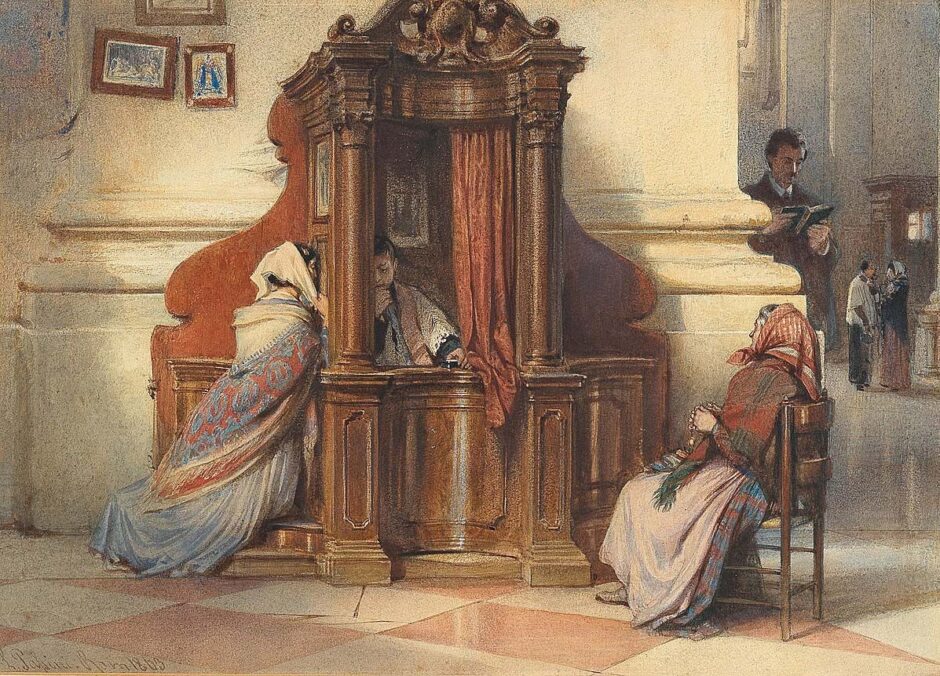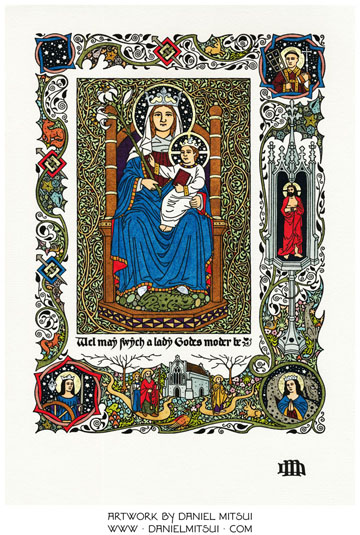 This spirit-filled offering comes from the UK’s best Catholic weekly, the Catholic Herald:
This spirit-filled offering comes from the UK’s best Catholic weekly, the Catholic Herald:
Meet Walsingham’s Catholic gin-makers
England’s great pilgrimage site now has a gin distillery inspired by the Faith
Every year 250,000 people make the journey to Walsingham, a remote village in Norfolk which since the 11th century has been one of Europe’s great pilgrimage sites. They may not know it, but on the way they pass a new business venture partly inspired by the faith: Archangel Gin, a Norfolk-based drink made with locally grown juniper, and distilled, bottled and labelled in the area.
The name is no accident. “The road that passes by the back wall of the distillery has been part of the pilgrimage route to Walsingham for hundreds of years,” says co-founder Peter Allingham. “I imagine that there have been tens of thousands of guardian angels walking that route beside their charges. I’m very keen on guardian angels. We put them to so much trouble but they never desert us.”
Allingham has many strings to his bow. He is an IT specialist, amateur Egyptologist and farmer. He’s in his early 50s, as is co-founder Jude De Souza, a London-based statistician and former BBC audience researcher. Two years back they joined forces and built their own distillery on Peter’s family farm.
“Our family has two farms in Norfolk with lots of lovely old buildings which were rather underused,” Allingham says, “so I thought ‘Gin-making sounds fun – let’s do it!’ Sometimes you just have to go for it.”
The design of the angel on the label is “inspired by the highly stylised angels from the Watts Cemetery Chapel at Compton in Surrey,” Allingham explains. “I’ve had those images in my head since I first saw them about 30 years ago.” The seal on the bottle-cap foil reads Angeli ab oriente: “The distillery is in the heart of the diocese of East Anglia and I like to think of our products as Angels from the East,” he says.
The gin draws on local history, too. “We wanted to make something that wasn’t a standard London Dry. There was a heavy Dutch influence in our part of Norfolk in the 16th to 19th centuries. You see that in the many Dutch-style houses in local ports. So making something that paid a little homage to traditional Dutch genever was very much in mind.”
[…]
I have always wanted to go to Walsingham. Now, more than ever. I love the entrepreneurial spirit.
Speaking of Our Lady, Daniel Mitsui has a wonderful rendering:

































The name “Allingham” and the area of East Anglia bring to mind the great mystery writer, Margery Allingham. I wonder if this gentleman is related?
Anyway, a well-made local gin is a very nice thing, and it sounds like they have some good ideas to make it stand out.
Argh. Make that “Norfolk.” Argh.
As I went to Walsingham,
To the shrine with speed,
Met I with a jolly palmer[1]
In a pilgrim’s weed.
Have a GnT and listen to John Dowland’s music:
[Well done.]
It has also received excellent reviews: https://ingoodtasteuk.com/archangel-gin/
“Archangel is certainly a rich, heavy and complex gin. On the face of it, the list of botanicals is daunting – juniper, verbena, orange peel, cinnamon, cloves, ginger, sea buckthorn, and cardamom. You can’t help but wonder how they’ll work together? Surely the flavours are too powerful and will fight with one another? Allingham even professes that they were “deeply apprehensive and thought we’d have to start all over again” when they tasted it straight from the still. Well, far from it. After allowing the distilled product to settle and infuse for five weeks, the result is gin perfection. The botanicals work in perfect harmony and, while full-bodied, the gin isn’t overpowering; in fact it has a beautifully smooth finish. It is a gin of real craft, refinement and, best of all, has none of the harshness that many have on the finish.
Of course, none of this matters if it doesn’t make a great G&T and, unsurprisingly, they had great fun trying to find the perfect mix. What they ended up with was a surprise to all – Fever Tree with orange peel to garnish. Worried that Fever Tree might be too powerful for the gin, it was a late entry to the tonics tested, and orange peel rounds off each of the botanicals beautifully, as I discovered at a private tasting with Allingham last weekend.
We even set about trying to find the perfect recipe for an Archangel Martini and found, quite contrary to logic, that the Bramley & Gage dry vermouth was the perfect vermouth for it. This vermouth is infused with numerous botanicals, including wormwood that, on the face of it, would seem too much to pile onto the botanicals of a gin, especially the floral, spicy and complex botanicals in Archangel. Again accompanied with a twist of orange, it makes for a stunning cocktail; the botanicals all play together rather than overpowering one another.
A link to the distillery is also in order: https://www.archangel-distilleries.co.uk/
Sancta Seryn eos protegat (et inspiret).
There’s no problem, Suburbanbanshee! East Anglia as a geographical term includes Norfolk. And Cambridgeshire, including the wonderful Cathedral of Ely. Well worth seeing, and Peterborough too.
And what an educated gentleman Mr. Allingham is, I must say. In the best English tradition.
O thanks for the Gold Star! I remember playing that song on my recorder in my teens. It’s very catchy.
Walsingham is situated very near the town of King’s Lynn and King’s Lynn also happens to be the name of a hymn tune – and guess who the most famous lyrics? One of Fr Z’s favourites :-)
https://www.youtube.com/watch?v=etI_QRNJfkw
Daniel Matsui puts so many fun and interesting items in his artwork. Is that a frog at Our Lady’s feet? I’ve learned to scour them to see what he’s hidden. Lovely.
For the sluggish days of late January, this gin post and comments are a sure tonic.
Kathleen10 – Our Lady’s feet are resting on a “toadstone”. In the Middle Ages, toadstones represented evil.